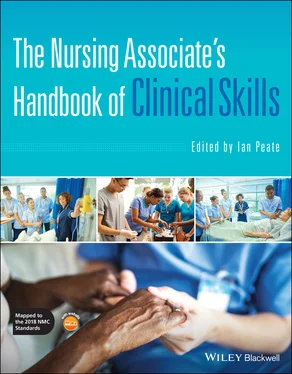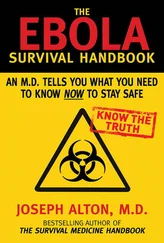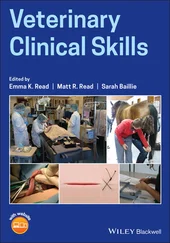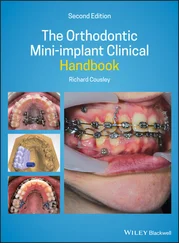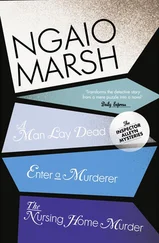The Nursing Associate's Handbook of Clinical Skills
Здесь есть возможность читать онлайн «The Nursing Associate's Handbook of Clinical Skills» — ознакомительный отрывок электронной книги совершенно бесплатно, а после прочтения отрывка купить полную версию. В некоторых случаях можно слушать аудио, скачать через торрент в формате fb2 и присутствует краткое содержание. Жанр: unrecognised, на английском языке. Описание произведения, (предисловие) а так же отзывы посетителей доступны на портале библиотеки ЛибКат.
- Название:The Nursing Associate's Handbook of Clinical Skills
- Автор:
- Жанр:
- Год:неизвестен
- ISBN:нет данных
- Рейтинг книги:4 / 5. Голосов: 1
-
Избранное:Добавить в избранное
- Отзывы:
-
Ваша оценка:
- 80
- 1
- 2
- 3
- 4
- 5
The Nursing Associate's Handbook of Clinical Skills: краткое содержание, описание и аннотация
Предлагаем к чтению аннотацию, описание, краткое содержание или предисловие (зависит от того, что написал сам автор книги «The Nursing Associate's Handbook of Clinical Skills»). Если вы не нашли необходимую информацию о книге — напишите в комментариях, мы постараемся отыскать её.
The Nursing Associate’s Handbook of Clinical Skills
The Nursing Associate’s Handbook of Clinical Skills
The Nursing Associate's Handbook of Clinical Skills — читать онлайн ознакомительный отрывок
Ниже представлен текст книги, разбитый по страницам. Система сохранения места последней прочитанной страницы, позволяет с удобством читать онлайн бесплатно книгу «The Nursing Associate's Handbook of Clinical Skills», без необходимости каждый раз заново искать на чём Вы остановились. Поставьте закладку, и сможете в любой момент перейти на страницу, на которой закончили чтение.
Интервал:
Закладка:
Table 7.2 An overview of the RSVP escalation method.
| RSVP ELEMENT | ACTIONS | EXAMPLE |
|---|---|---|
| Reason | State your name and role and confirm who you are talking to. Give the patient’s name and location. Give the reason for the call. | My name is Janusz Nowak; I’m a nursing associate. I’m calling about a patient, Jane Doe, on Ward 1, who is experiencing chest pain currently. |
| Story | Give the background information about the patient, reason for admission, relevant past medical history and resuscitation status. | Jane is an 85‐year‐old female admitted two days ago with raised troponin test leading to a diagnosis of non‐ST elevation myocardial infarction. She is awaiting an inpatient angiogram. Her past medical history is hypertension and angina. Her resuscitation status was assessed yesterday and she is for resuscitation. |
| Vital Signs | Give abnormal vital signs as well as sign/symptoms and a description of your visual assessment of the patient. | She appears pale and her skin is clammy. She is tachypnoeic with a respiration rate of 28, tachycardic with a heart rate of 112, with a weak, palpable radial pulse. She is hypotensive with a blood pressure of 92/56. All other observations are within normal parameters. Her total NEWS score is 7. |
| Plan | Give your current plan and ask for a further plan from the recipient. Ask now for anything you want them to do. | We are going to connect to a monitor and complete serial ECGs. Please come and assess this patient immediately. |
Registered Nurse
A registered nurse is a healthcare professional who has expertise in the delivery of professional nursing care to patients. It is important to remember that registered nurses possess a number of assessment, evaluation and clinical decision‐making skills as well as specific knowledge of disease pathology, pharmacology/medicines management and non‐medical treatments and therapies within the context of compassionate and caring nursing skills.
Registered nurses also maintain accountability for patients under their care, and consequently, a registered nurse should be notified of your assessment of the patient.
The registered nurse may have the ability to manage a patient by putting into place a plan of care which may not necessarily require the patient to be escalated to a physician or other healthcare professional. Registered nurses may have significant experience in the specialism and have developed additional specialist skills and knowledge; they may have access to patient group directives or be non‐medical prescribers, allowing them to administer medications without a direct prescription and as such, and they can be consulted for advice and intervention.
Nurse Practitioners (NPs)/Advanced Clinical Practitioners (ACPs)
These are registered nurses and sometimes practitioners from other healthcare professions who have advanced training, skills and knowledge which may overlap that of medical practitioners. NPs and ACPs may be able to provide advice, intervene and provide monitoring beyond that of other registered nurses and healthcare professionals.
Foundation Year 1 (FY1) and Foundation Year 2 (FY2) Doctors
FY1 doctors are ‘newly qualified’ doctors undergoing a pre‐registration year of experience under very close supervision of a consultant or GP. FY2 doctors have completed the FY1 year and have obtained full registration as a doctor but remain under the supervision of a consultant. When working in a hospital, these are often the first point of contact for concerns about patients.
Core Trainee Or Specialist Trainee Doctors
These are doctors who have completed their foundation training and are now developing in their specialist field of medicine. These doctors are more experienced, and in the later years of training, they are often still referred to as an older term ‘Specialist Registrars’, meaning they are in the final stages of their training to become a consultant.
Consultant
A consultant is a doctor who has completed speciality training in their specialist medical field. It is rare that consultants provide immediate response to patient concerns; but many are approachable and will often be contacted by more junior doctors for advice and guidance.
Critical Care Outreach Team
Acute hospitals may have a critical care outreach team comprised normally of registered nurses (and sometimes other roles) with significant clinical experience in intensive care or the emergency department and therefore expert at assessing, monitoring and treating unwell and deteriorating patients.
Critical care outreach teams may also provide ongoing monitoring for unwell patients on wards and provide advice and support to nursing and medical staff.
Outreach teams may also carry out other technical roles too, for example, monitoring patient‐controlled analgesia.
Medical Emergency Team (MET)/Crash Team
A medical emergency team (MET) or ‘Crash Team’ can be contacted on 2222 in an emergency in an acute hospital in the United Kingdom. This team comprises selected on‐call clinicians normally from the on‐call medical team, intensive care teams and critical care outreach teams who respond when called to a medical emergency. The Crash Team is also summoned by calling 2222 and is normally the same clinicians from the MET, although other staff such as resuscitation officers and anaesthetists may also respond to a crash call.
999 Emergency Services
In patient homes, GP surgeries, community hospitals and other community settings, the most appropriate response to a deteriorating patient is the ambulance service; within the United Kingdom, an emergency ambulance is arranged by calling 999.
The first person you speak to will be an operator who will ask you which emergency service you require and will connect you to the ambulance service when asked to. The next person you speak to will be an ambulance service call taker who is not a healthcare professional; therefore, it is important to give clear information about the patient, and this will enable them to complete a triage pathway and arrange the most appropriate response.
They will ask you a set of questions from a protocol which you must answer, even if they seem inappropriate, given your professional role. On arrival of the ambulance, you will normally handover to a clinician such as a paramedic, emergency care practitioner, ambulance technician or registered nurse all of whom have expertise in the management of unwell patients.
Violet Flag
 The task of passing on important information related to an escalation of concern occurs in every care setting and between care settings (transfers of care) every day, for example, in a person’s own home, the back of ambulances when transferring a patient for place of detention a hospital, community clinics, GP surgeries, to name a few. It is just as important in any of these care settings to ensure that the handover, the escalation of concern, is timely and performed in a systematic manner.
The task of passing on important information related to an escalation of concern occurs in every care setting and between care settings (transfers of care) every day, for example, in a person’s own home, the back of ambulances when transferring a patient for place of detention a hospital, community clinics, GP surgeries, to name a few. It is just as important in any of these care settings to ensure that the handover, the escalation of concern, is timely and performed in a systematic manner.
In acute and community inpatient hospitals in the United Kingdom, the use of the National Early Warning Score (NEWS) is now embedded into policies regarding identifying and escalating concerns about patient’s clinical observations, with a scoring system used to identify who should be contacted to provide further assessment of the patient. NEWS is discussed later in the chapter.
Читать дальшеИнтервал:
Закладка:
Похожие книги на «The Nursing Associate's Handbook of Clinical Skills»
Представляем Вашему вниманию похожие книги на «The Nursing Associate's Handbook of Clinical Skills» списком для выбора. Мы отобрали схожую по названию и смыслу литературу в надежде предоставить читателям больше вариантов отыскать новые, интересные, ещё непрочитанные произведения.
Обсуждение, отзывы о книге «The Nursing Associate's Handbook of Clinical Skills» и просто собственные мнения читателей. Оставьте ваши комментарии, напишите, что Вы думаете о произведении, его смысле или главных героях. Укажите что конкретно понравилось, а что нет, и почему Вы так считаете.
